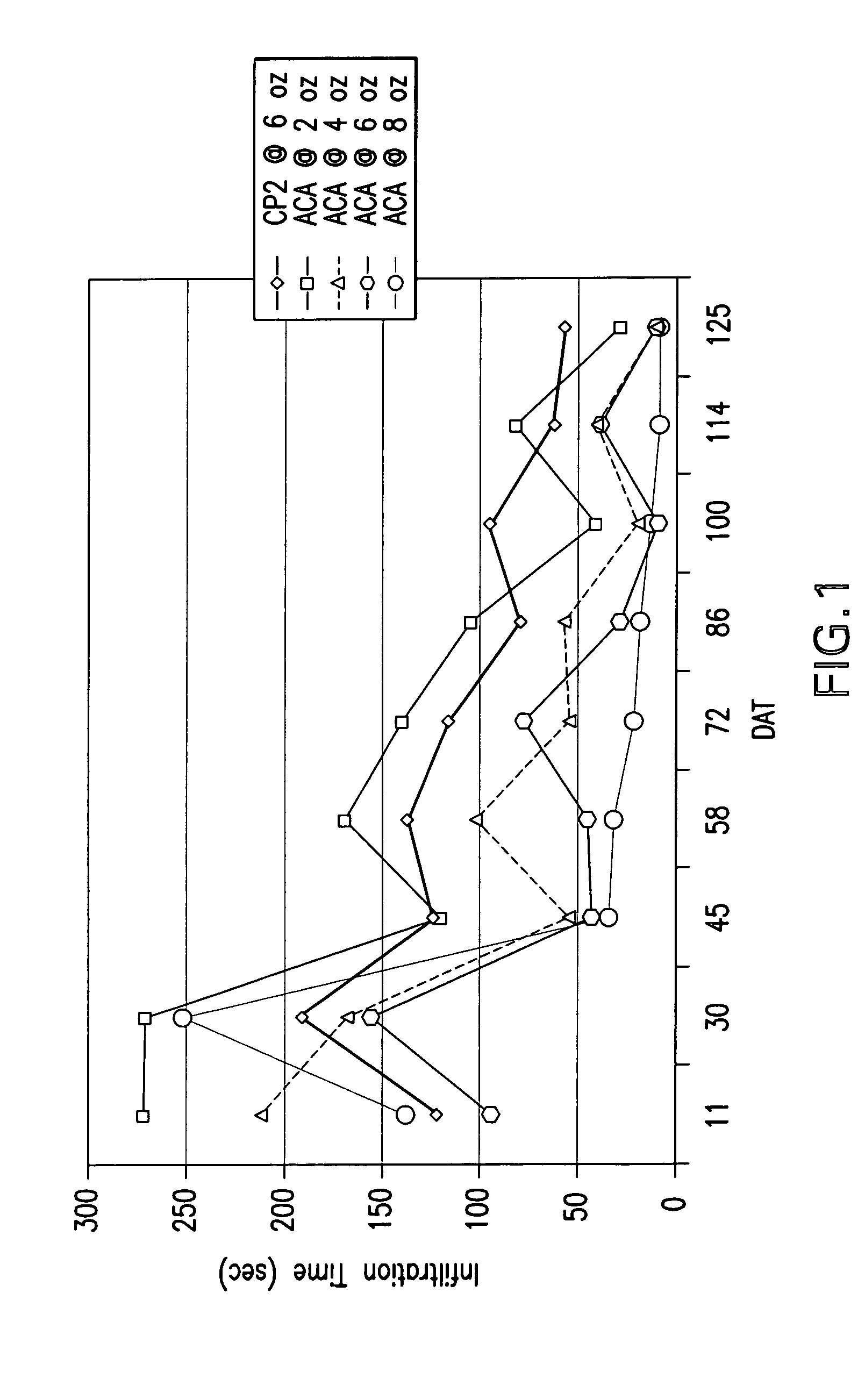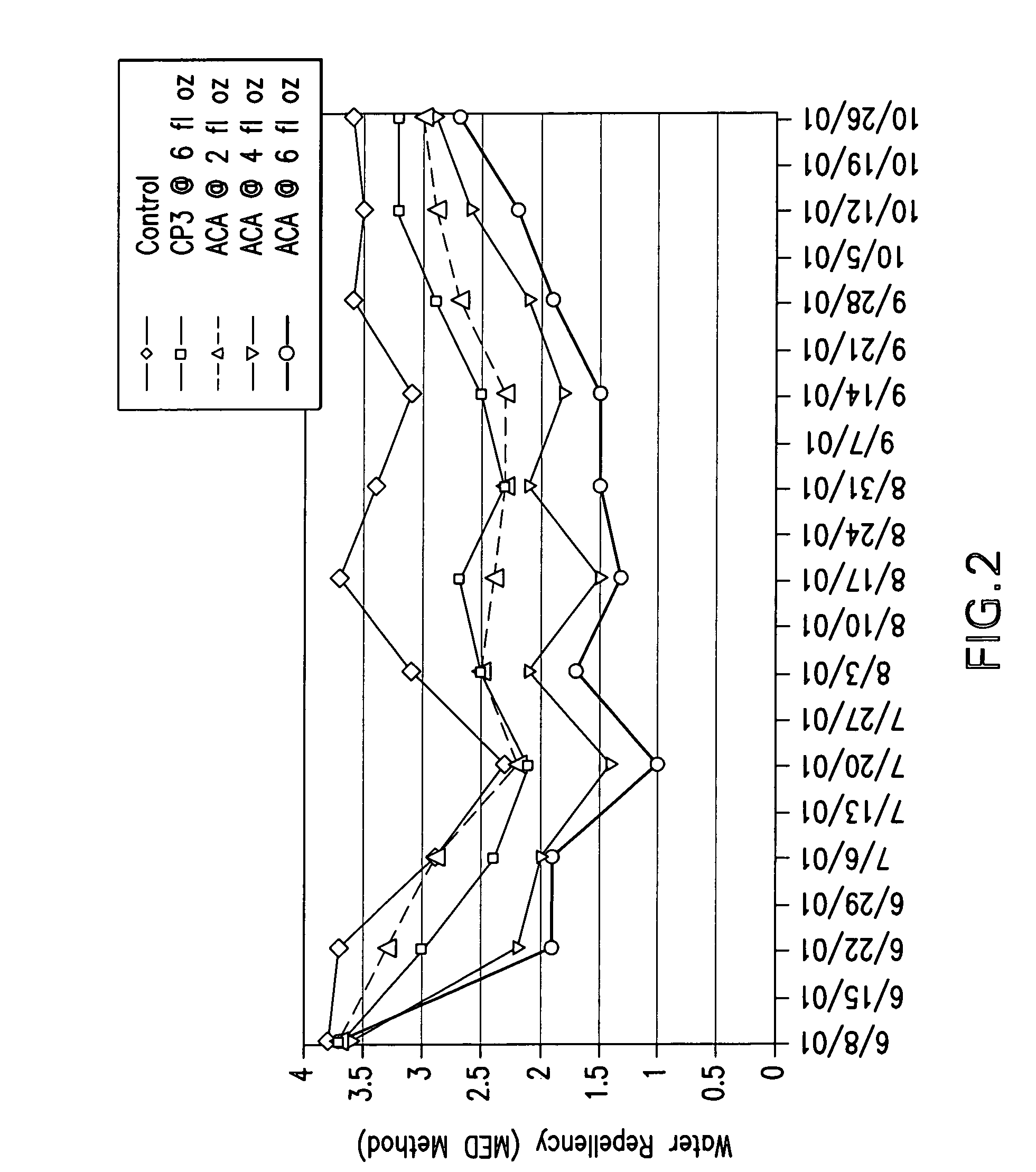Enhancing plant productivity by improving the plant growth medium environment with alkyl ethers of methyl oxirane-oxirane copolymer surfactants
a technology of oxirane and surfactants, which is applied in the field of enhancing the productivity of plants, can solve the problems of dire environmental consequences, inability to grow well or even survive plants, and inability to resist soil, so as to improve certain desirable characteristics of plant growth medium, enhance aqueous re-wetting infiltration rate, depth, and longevity
- Summary
- Abstract
- Description
- Claims
- Application Information
AI Technical Summary
Benefits of technology
Problems solved by technology
Method used
Image
Examples
example 1
[0040]A micro-scale Soxhlet extraction was conducted using a commercially available, hydroxy terminated methyl oxirane-oxirane copolymer (hereinafter identified as the Comparative Product 1 aka CP1) and a methyl ether of a methyl oxirane-oxirane copolymer (identified herein as ACA), both having a molecular weight of about 2,500, on water repellent soil samples to determine the relative ability of the compounds to solubilize components of a soil sample.
[0041]Hydrophobic soil was obtained from a site in the New Jersey Pine Barrens and dried down in a convection oven for seven days at 70° C. The soil was then sieved to remove unwanted debris and achieve a particle size of less than 500 micrometers. Approximately 2.50% surfactant by weight was loaded onto the soil and allowed to air-dry.
[0042]A micro-scale Soxhlet extraction apparatus was constructed comprising three primary components, to wit, a central chamber for holding a cellulose extraction sample thimble and having a sidearm for ...
example ii
[0046]The water repellent soil which is used in the following tests is made by coating a hydrophilic sand with octadecyl trichloro silane (OTS) as described by Bauters, et al., 1998 Soil Sci. Soc. Am. J. 62: 1185-1190.
[0047]Using the aforedescribed Straw Test, the time in seconds for distilled water to infiltrate through a six centimeter column of this water repellent soil is determined through three replications. The results are set forth in Table II.
[0048]
TABLE IITreatmentReplication 1Replication 2Replication 3AverageDistilled Water604,800 s691,200 s604,800 s633,600 s
[0049]These numbers indicate the base-line hydrophobicity of this mineral soil and serve as the control in the quantification of the performance of wetting agent compositions tested.
[0050]Since the infiltration time values obtained with the instant mineral soil prepared above all exceed seven days (86,400 seconds per day), this soil is obviously extremely hydrophobic, i.e., clearly water repellent.
[0051]CP1 and ACA in...
example iii
[0053]A second series of Straw Tests is conducted using extremely water repellent soil prepared by coating a basic sand selected from a different but similar lot to that used in Example II, with octadecyl trichloro silane (OTS) as described in Example II.
[0054]CP1 and the ACA in concentrations as indicated below are again examined using the Straw Test in order to ascertain the ability of the surfactants to affect the infiltration wetting rate of a second water repellent soil described above. Each test is replicated three times. The results of the tests in seconds are set forth in Table III below.
[0055]
TABLE IIITotal Concentrationin Water (ppm)Product800060004000ACAReplicate 1145150285Replicate 2189155122Replicate 3175220201Average170175202CP1Replicate 1227320375Replicate 2147220219Replicate 3370340315Average248293303
PUM
 Login to View More
Login to View More Abstract
Description
Claims
Application Information
 Login to View More
Login to View More - R&D
- Intellectual Property
- Life Sciences
- Materials
- Tech Scout
- Unparalleled Data Quality
- Higher Quality Content
- 60% Fewer Hallucinations
Browse by: Latest US Patents, China's latest patents, Technical Efficacy Thesaurus, Application Domain, Technology Topic, Popular Technical Reports.
© 2025 PatSnap. All rights reserved.Legal|Privacy policy|Modern Slavery Act Transparency Statement|Sitemap|About US| Contact US: help@patsnap.com



